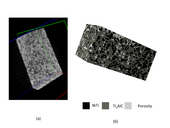Highlight
Modeling of a hybrid Shape Memory Alloy Ceramic Composite
Achievement/Results
In the aerospace and other industries, the development of a material capable of withstanding extreme, high-temperature environments remains an active area of investigation. Such materials are needed for atmospheric reentry, hypersonic flight or for engine components. To this end, a team of researchers at Texas A&M University is developing a new hybrid metal-ceramic composite to address this need. Specifically, a new model describing the behavior of this composite was developed and used to explore the material response. Importantly, this material system combines two unique constituent phases not previously considered – Shape Memory Alloys (SMAs) and MAX phase ceramics. Shape memory alloys, the most common of which is NiTi, are a multifunctional material which undergoes a diffusion-less, solid-to-solid phase transformation resulting in a change in the microscopic crystallographic structure. Large strains (displacements) are associated with this transformation resulting in implementation of SMAs as actuating or transforming devices.
Examples of SMA applications include biomedical heart stents, an actuating chevron for jet engine exhaust being explored by Boeing and couplers for the petroleum industry. To expand the usage of SMAs, our work is focused on how SMAs and their unique capabilities may be used to enhance the performance and/or properties of a composite. Specifically, in the case of the proposed hybrid composite, it is envisioned that SMAs and their associated transformation may be used to take advantage of the superior mechanical performance of ceramics when compressively loaded. To produce this effect, the unique capability of MAX phase ceramics (e.g. Ti3SiC2, Ti2AlC) to develop permanent deformations is used in conjunction with the SMA phase.
As these materials have not been previously produced, a new model was developed to explore these effects and analyze the interactions of the different constituent phases. Importantly, manufacturing of these composites leads to a irregular, heterogeneous phase distributions (microstructures). This effect was accounted for and considered by developing computational domains (meshes) from results of microstructure characterization (Fig. 1). In such a fashion, effects of individual features maybe identified for feedback to collaborators manufacturing the materials.
Using the above model, the effective composite response to loading was determined. Specifically, the response to a traditional SMA strain-temperature loading path was determined for a variety of applied loads (Fig. 2). Importantly, it was shown that effective response still shows transformation characteristics of a shape memory alloy. Through these efforts, unique effective transformation behaviors were observed in the composite response not seen in pure SMA due to the interaction of the two phases. Through such efforts, it was also demonstrated that SMA transformation may be used in this hybrid composite to develop a residual stress state. Specifially, through a tensile actuation (isobaric thermal cycle) loading path, a compressive residual stress may be developed in the ceramic phase. The final stress state in the ceramic phase following such a path is presented in Fig. 3.
Address Goals
This work was performed by Brian T Lester, Professor Dimitris Lagoudas, and collaborators at Texas A&M University. Brian is a PhD student in Aerospace Engineering and currently a part of the “New Mathematical Tools for Next Generation Materials” interdisciplinary team at Texas A&M with support from the NSF-IGERT (Integrative Graduate Education and Research Traineeship) program. Through this program, Brian’s graduate education has included interdisciplinary coursework in math, material science and mechanics of materials. This research is part of a larger collaborative AFOSR MURI including several departments at Texas A&M, the University of Illinois, Stanford, Virginia Tech, the University of Michigan, and UDRI. Specifically, the research discussed here is part of an interdisciplinary collaboration with faculty and students in the Mechanical Engineering departments and the Materials Science program at Texas A&M who are manufacturing this material system for the first time.
These complementary efforts require extensive communication fostering an interdisciplinary environment involving discussions and training in materials development and manufacturing, mechanics of materials and experimental and computational materials investigations. The work on microstructure characterization and image-based techniques was a result of internships with collaborators at the US Naval Research Laboratory enhancing the interdisciplinary experience. This work on hybrid SMA composites is part of the larger efforts of IGERT co-PI Dimitris Lagoudas in developing constitutive models for a variety of materials. These investigations include efforts on a diverse group of material systems ranging from polymer composites with carbon nanotubes to shape memory polymers and alloys. Students working on these projects have come from the aerospace department and materials science program including 4 past and 2 current IGERT trainees. This interdisciplinary environment and range of topics has produced top-tier, diverse engineers and researchers working on cutting edge topics in a variety of disciplines addressing issues of current importance in the aerospace, biomedical, petroleum and other industries.








